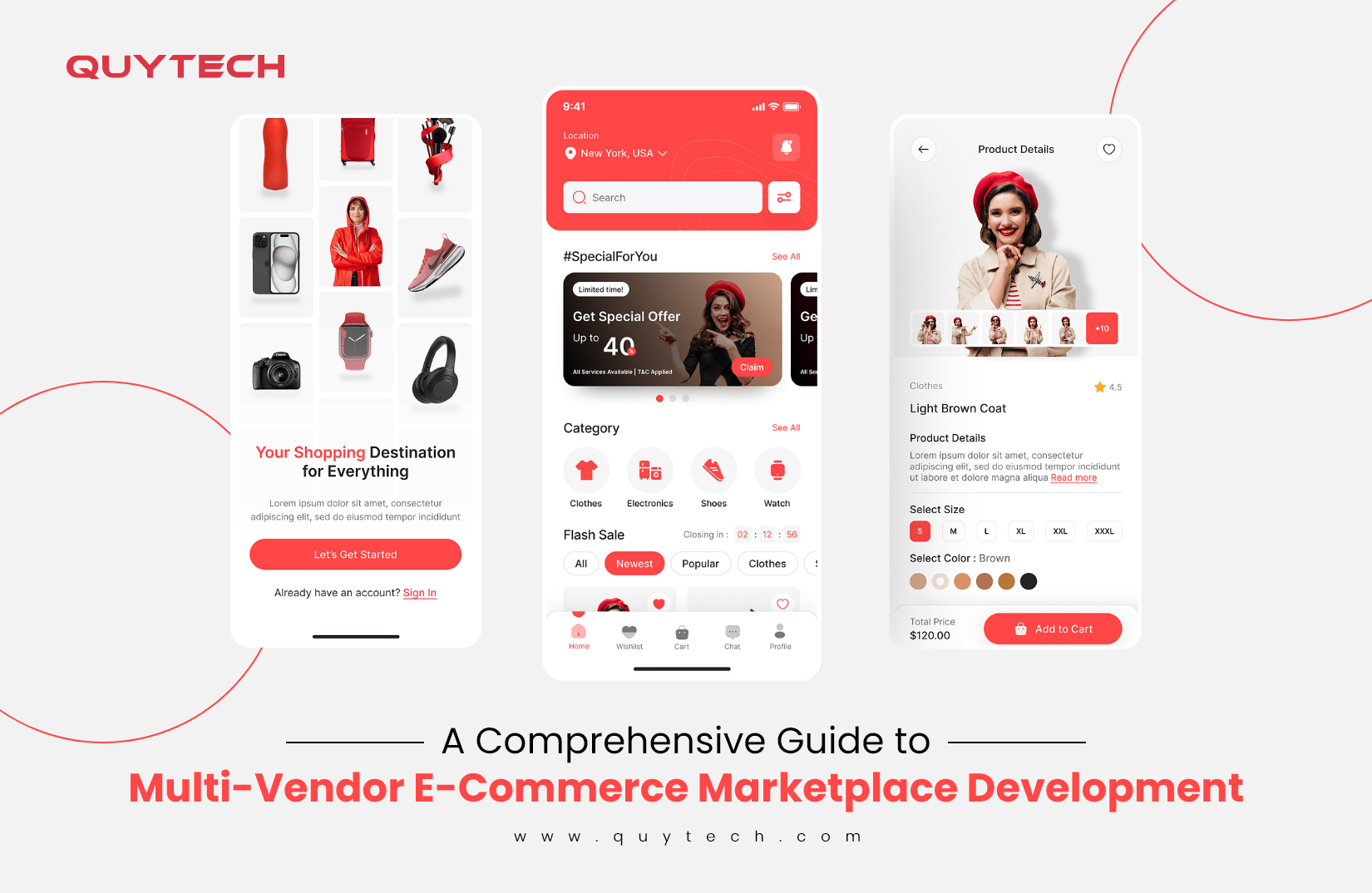This blog includes a step-by-step multi-vendor e-commerce marketplace development process in the beginning. Those who want to know everything else, such as benefits, types, working, trends, and more, about multi-vendor e-commerce marketplaces, read the blog till the end.
Amazon witnessed a 14% increase in its fourth-quarter sales in 2023, making a whopping $170 billion. Similarly, eBay generated a revenue of $2.6 billion in the fourth quarter of 2023. You must be thinking why we are talking about these numbers. It’s simply to give you an idea of the popularity of multi-vendor e-commerce marketplaces.
Yes, you read that right. Amazon, eBay, and other popular marketplaces are making billions merely by providing vendors and sellers a platform to list and sell their products. The rising popularity and soaring profits have also increased the demand for multi-vendor e-commerce marketplace development.
If you plan to develop a multi-vendor e-commerce marketplace like Amazon, eBay, or Alibaba, then this guide is exclusively for you. Here, we have explained the stepwise development process, features, types, benefits, and other crucial elements of such a marketplace. Let’s begin!
What is a Multi-Vendor E-Commerce Marketplace?
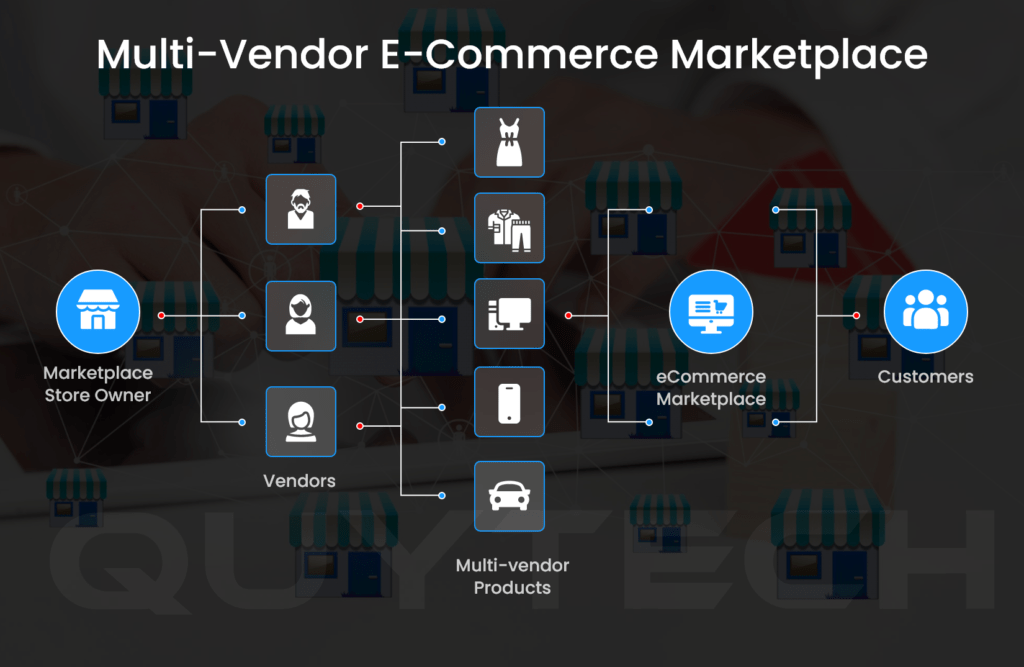
Understanding a multi-vendor e-commerce marketplace is quite simple. It is a digital marketplace that allows multiple vendors or sellers to showcase and sell their products and services without investing in developing a standalone application, which requires significant cost.
Multi-Vendor E-Commerce Marketplace Development Process
Let’s quickly begin with the development process of a multi-vendor e-commerce marketplace:
(Please note that the below development process is what most reputed e-commerce marketplace development companies follow. It may vary slightly depending on your unique project needs.)
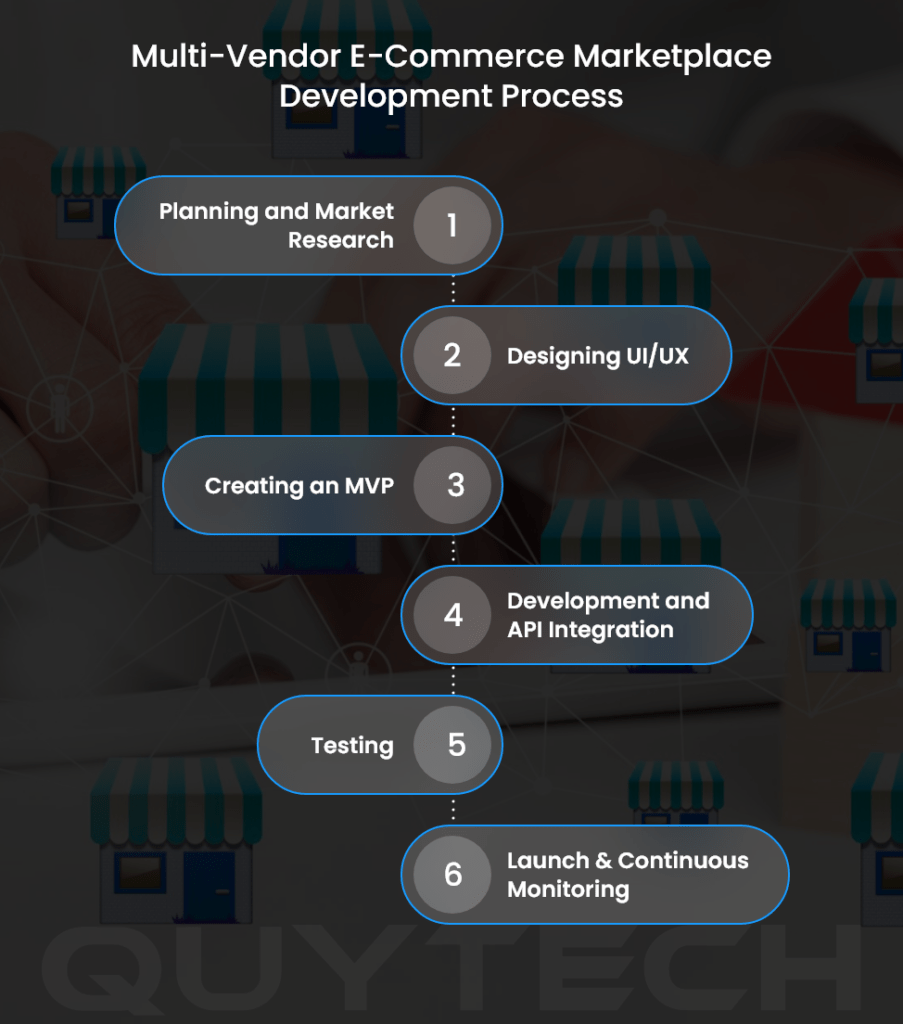
- Planning and Market Research
The first step involves researching competitors, identifying their USPs and weaknesses, and exploring the market trends in multi-vendor e-commerce marketplace development. It also involves deciding the marketplace’s platform, tech stacks, monetization strategies, and features for successful development.
- Designing UI/UX
It involves designing visually appealing UI/UX design with clear navigation and functionality. If you are building a marketplace for multiple platforms then make sure its design, look, and feel are consistent across all platforms.
- Creating an MVP
An MVP or minimum viable product is a representation of the final marketplace but with only essential features and functionality. Launching an MVP first among your stakeholders and target audience would help you collect their feedback and develop a marketplace that exactly meets their needs and has a higher chance of success.
- Development and API Integration
This phase includes developing a full-fledged online marketplace with all the required features and functionalities using the most suitable technologies and platforms. It also includes integrating APIs to add multiple modes of payments, vendor management, shipping and warehouse management, inventory management, and other functionalities.
- Testing
Verifying the marketplace’s security, usability, performance, and functionality by running multiple tests is the main aim of this phase. It also involves resolving the bugs if any identified during the testing.
- Launch and Continuous Monitoring
Launching the marketplace on the desired platform is the last step of the multi-vendor e-commerce marketplace development process. Once successfully deployed, the marketplace is monitored continuously for performance and user feedback to make necessary changes or add new features in the future.
Similar blog: How to Develop an Online MarketPlace App Like eBay
Technology Stack Required to Build a Multi-Vendor E-Commerce Marketplace
There are different types of multi-vendor e-commerce marketplaces that one can choose to build. Selecting the tech stack depends on the type, features, platform (website or mobile application), and a number of other factors. However, some common technologies required for the development are as follows:
| Front-end | React.js, Angular, Vue.js, React Native, Flutter |
| Back-end | Node.js, Django, Ruby on Rails |
| Cloud Network | Amazon AWS, Google Cloud Platform, Microsoft Azure |
| Database | MySQL, PostgreSQL, MongoDB |
| Analytics | Google Analytics |
| Security | HTTPS, SSL Certificates |
| E-Commerce Platform | Magento, WooCommerce, Shopify, etc. |
Multi-Vendor E-Commerce Marketplace: How Does it Work
A multi-vendor online marketplace generally works as follows:
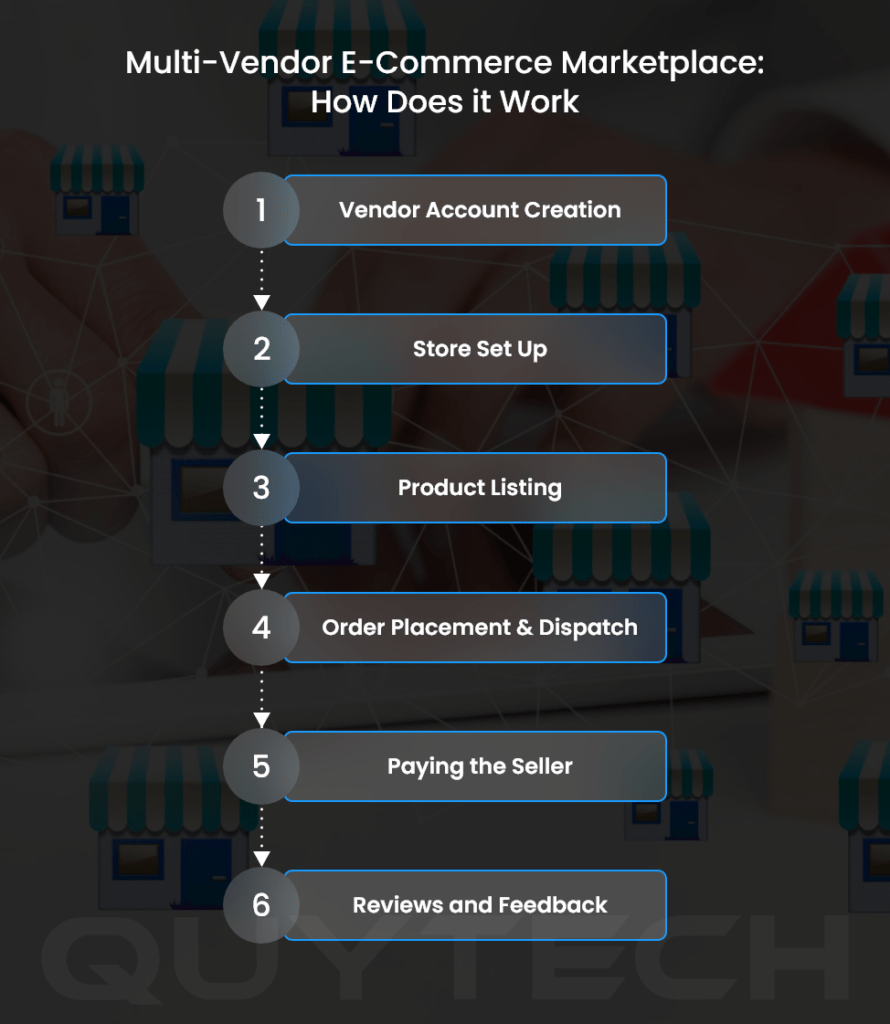
- Vendor Account Creation: Sellers create their vendor accounts and set up their profiles by providing details such as contact information, shipping options, etc.
- Store Set Up: The next step is to set up the store in the marketplace by entering essential information like providing images and descriptions of the product, selecting the store theme, managing inventory, etc.
- Product Listing: This step requires the seller to list all the products and their accurate image/video, description, price, shipping information, and other details that can help the customer know about the item.
- Order Placement and Dispatch: When a customer places an order, the multi-vendor marketplace sends a notification, including the order details, to the seller. The seller packs and ships the product to the customer’s address, shares its tracking link, and updates the product status.
- Paying the Seller: Most marketplaces charge a commission fee, either fixed or variable depending on the products’ sale, to enable sellers to use their platform. The marketplace deducts their fees and sends the remaining amount to the seller’s account.
- Reviews and Feedback: Customers get a notification to share their feedback about the product. Their feedback helps other buyers to know the products’ quality, fit, and more.
One advantage the seller gets in this entire process is that the multi-vendor marketplace offers required customer support services to answer customers’ questions or update them with the status of their orders.

Benefits of Multi-Vendor E-Commerce Marketplace
A multi-vendor e-commerce marketplace offers immense advantages to all stakeholders, i.e., customers, sellers, and the administrator. Let’s dig deeper into to know all of them:
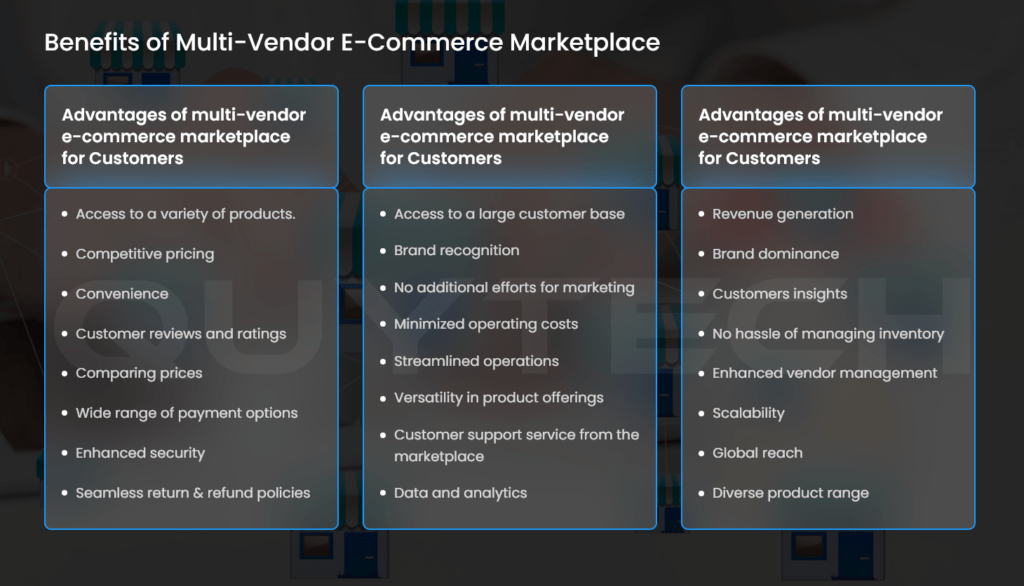
Benefits of Multi-Vendor E-commerce Marketplace for Customers
Access to a variety of products
An e-commerce marketplace provides customers seamless access to a variety of products, such as electronics, apparel, home furnishing, etc. They don’t have to visit multiple websites or shopping portals to buy different items.
Competitive pricing
A marketplace lists multiple sellers on one platform. This raises competition and to stay ahead, sellers offer competitive pricing and exciting deals to customers.
Convenience
With a multi-vendor e-commerce platform, customers can get the convenience of browsing, comparing, and purchasing products at any hour of the day. Unlike physical stores, online marketplaces remain open 24*7.
Customer reviews and ratings
At multi-vendor online marketplaces, customers get the option to share their reviews and ratings. Other customers can check those reviews to get a better idea of products’ quality and seller’s reliability.
Comparing prices
In a marketplace, customers can easily compare the price of a single product on multiple sellers’ storefronts. They can choose the best deal and save big.
Wide range of payment options
Online multi-vendor marketplaces offer customers the convenience of paying through debit/credit cards, wallets, net banking, and other modes of payment. It increases customer satisfaction and ensures quick payments.
Enhanced security
Muli-vendor e-commerce marketplaces deal with sensitive information of customers and sellers; to safeguard this information, they implement robust security measures and techniques. It enhances the overall security of the marketplace and creates a secure and trusted environment.
Seamless return and refund policies
Online marketplaces have well-structured and well-defined return and refund policies that customers can easily check before shopping. It makes the entire shopping experience reliable and stress-free.
Benefits of Multi-Vendor E-commerce Marketplace for Sellers
Access to a large customer base
By choosing a multi-vendor e-commerce marketplace, sellers can directly reach out to a large customer base. This reduces additional efforts to find ways of connecting with customers which is important to increase sales and revenue.
Brand recognition
Having a presence in a reputed marketplace gives small businesses the brand visibility and trustworthiness that takes years to build and earn. It attracts customers and fosters their trust in the products or services.
No additional efforts for marketing
A business spends a significant amount of money to market its products/services. However, being a part of a multi-vendor marketplace eliminates this need as most marketplaces have effective strategies to promote their platform.
Minimized operating costs
With an e-commerce marketplace for multi-vendors, sellers don’t have to invest in building a standalone application or website. Not just this, they don’t have to worry about the cost associated with website hosting and security. It minimizes the operational cost significantly.
Streamlined operations
Most online e-commerce marketplaces have built-in tools to manage inventory, process orders, handle payments, and other critical tasks. Sellers don’t have to invest in all these tools or worry about managing these operations.
Versatility in product offerings
A multi-vendor e-commerce platform offers sellers the flexibility to list different types of products, including physical objects and digital downloads.
Customer support service from the marketplace
Online marketplaces have dedicated customer support teams to interact with customers, help them with product browsing or purchase, or address the problems they are experiencing. Sellers don’t have to worry about this service.
Data and analytics
Sellers can get crucial customer insights that can help to understand their requirements and alter their strategies. They can also check their performance to stay competitive.
Benefits of Multi-Vendor E-Commerce Marketplace for Administrator/Owner
Revenue generation
A multi-vendor e-commerce marketplace offers admins multiple ways of revenue generation. They can earn through commission fees, listing fees, and premium services (for example, sponsoring a seller in any particular segment they want).
Brand dominance
An online e-commerce marketplace with a large number and variety of sellers and customers has a higher chance of success and establishing a brand in the market. It can improve their market share significantly.
Customer insights
Advanced multi-vendor e-comm marketplaces built using artificial intelligence, enable admins to to gain critical insights associated with customer preferences and behavior. Admins can use these insights to make informed decisions.
No hassle of managing inventory
With a multi-vendor e-commerce marketplace, admins don’t have to manage inventories as sellers take care of everything at their end.
Enhanced vendor management
A feature-rich multi-vendor marketplace facilitates seamless management of vendors, their earnings, adherence to the platform’s guidelines, and more under one roof.
Scalability
Multi-vendor marketplaces, built by experienced technology companies, can scale to accommodate new sellers and products. It exponentially amplifies the marketplace’s value and reach.
Global reach
A multi-vendor online marketplace breaks the geographical barriers to reach vendors and customers across the globe, increasing revenue opportunities.
Diverse product range
A well-established marketplace attracts global sellers to list their diverse range of products on it. It increases the customer base, thus, benefitting the marketplace.

Types of Multi-Vendor E-Commerce Marketplace Explained
The multi-vendor online marketplaces can be further categorized into several types, including the following:
General Marketplaces
It includes B2B and C2C marketplaces like Amazon, Walmart, eBay, and more where customers can explore and buy goods from multiple categories.
Niche Marketplace
In this type of marketplace, sellers or vendors can list only a specific category of products. One of the popular examples of the niche marketplace is Etsy, which accommodates handmade and vintage items only.
Service Marketplace
Service marketplace deals with services, instead of products. Vendors and sellers visit the online platform to sell and buy services. Some famous examples of service marketplaces are Upwork and Fiverr.
Rental Marketplaces
This type of marketplace enables vendors or owners to rent out their assets or services. Airbnb and Turo are a perfect example of rental marketplaces.
Digital Goods Marketplaces
As the name suggests, digital goods marketplaces offer a platform to sell digital items like music, e-books, software, and more. A few examples include Google Play Store, iTunes, and Spotify.
Features of Multi-Vendor E-Commerce Marketplace that Make It Successful
A multi-vendor e-commerce marketplace involves multiple stakeholders. The features for different stakeholders, i.e., sellers, customers, and admin, are different. Check them out below:
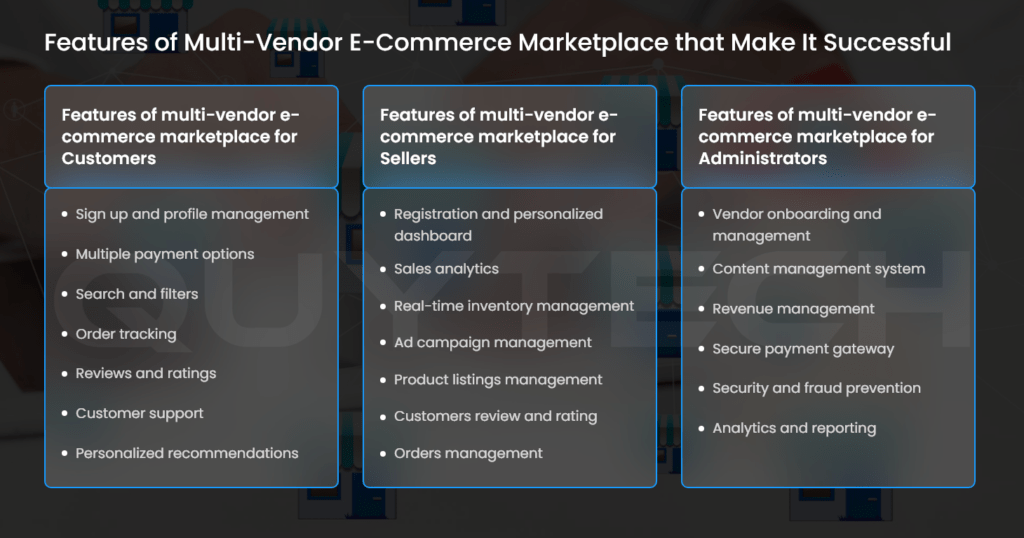
Multi-Vendor E-Commerce Marketplace Features For Customers
- Sign up and profile creation
With this feature, customers can easily create their accounts on the marketplace. They can also create and manage their profiles by entering required details, such as delivery address, contact number, etc.
- Multiple payment options
The feature enables customers to pay for their purchases by choosing from credit/debit cards, net banking, digital wallets, or any other mode of payment. They can ensure complete security while experiencing a seamless checkout process.
- Search and filters
A multi-vendor e-commerce marketplace with a search bar allows customers to find the products quickly. In other words, they don’t have to explore the categories. Similarly, filters enable them to refine the search results, saving time and enhancing experience.
- Order tracking
With the real-time order tracking feature, customers can track the status of their orders. They can check where exactly the product is and when it will reach their destination.
- Reviews and ratings
This feature enables buyers to submit ratings and reviews for the products they have purchased from the marketplace. This helps fellow customers to make informed purchase decisions.
- Customer support
Using the customer support feature, customers can connect with the marketplace’s support team via chat, email, or phone to get answers to their queries or need assistance with using the platform or finding products.
- Personalized recommendations
AI-powered e-commerce marketplaces include this feature that automatically suggests products/services to customers based on their browsing history, previous purchases, and preferences. It improves the shopping experience and increases the chances of sales.
Multi-Vendor E-Commerce Marketplace Features For Sellers
- Registration and personalized dashboard
With this feature, sellers can register themselves on the marketplace by providing the required details. Once registered, they can personalize their dashboard to list and manage products, check new orders, and more.
- Sales analytics
Using sales analytics, sellers can check crucial insights to measure their sales performance, total earnings, best-selling items, and more to make informed decisions.
- Real-time inventory management
The real-time inventory management feature enables vendors to keep their inventory status, out of stock, items left, etc., updated.
- Ad campaign and promotions management
Vendors can utilize this feature to create offers, discounts, and coupons for customers to enhance engagement and achieve customer satisfaction. It can also assist them with creating sponsored ads to increase their visibility and boost sales.
- Product listings management
The product listing management feature empowers vendors to list and manage the items they want to sell on the marketplace. They can verify that the products and descriptions are accurate, prices are precisely mentioned, and more.
- Customers review and rating
The feature allows vendors to check the ratings and reviews submitted by customers who have bought their products or availed of their services. Based on the feedback, they can alter their strategies or improve offerings.
- Orders management
The order management feature facilitates seamless processing and tracking of orders. It includes generating receipts, ensuring timely deliveries, managing returns, and more.
Multi-Vendor E-Commerce Marketplace Features For Admins
- Vendor onboarding and management
Seamless vendor onboarding and management is crucial for any multi-vendor e-commerce marketplace. This feature does this job by allowing admins to onboard and monitoring of sellers. They can also set commission rates, handle queries, and ensure adherence to the defined policies.
- Content management system
A multi-vendor online marketplace with a dedicated CMS makes it easy to create and manage product categories, banners, and other content required to increase the popularity of the platform.
- Revenue management
With this feature, administrators can manage revenue generated from offering services to different vendors or sellers.
- Secure payment gateway
This feature enables customers to pay for their purchases using multiple modes of payment, giving them the flexibility and convenience of making transactions.
- Security and fraud prevention
The feature helps to monitor the marketplace’s security practices, such as data encryption, security audits, and more. It also offers ways to prevent fraudulent activities.
- Analytics and reporting
The analytics and reporting feature allows admins to get detailed reports on sales, traffic, customers’ behavior, and more to plan new marketing strategies backed by data.
Read more: Advanced Features You Must Add to Your eCommerce Mobile App
How Do Multi-Vendor E-Commerce Marketplaces Make Money
Now that you have read enough about the multi-vendor e-commerce marketplace, let’s discuss different revenue models using which marketplace owners can generate income.
- Commission Fee
It includes getting commissions for every transaction that happens on the marketplace. In other words, whenever a product is purchased by a customer, the admin or marketplace owner gets a pre-decided percentage of the sale. The commission rate may vary based on the product category, seller performance, and other factors.
- Advertisement Fee
Multi-vendor e-commerce marketplaces allow sellers or vendors to promote their products to improve visibility and increase the chances of sales. For this, admins charge a certain advertisement fee depending on the model, like cost per click, cost per impression, or cost per action.
- Subscription/Membership Fee
Some vendors might choose to subscribe to the marketplace’s premium services or features to offer their customers benefits like free shipping or fast delivery. These services are chargeable, which means admins make it a way to generate revenue.
- Logistics Services
Multi-vendor e-commerce marketplace owners can offer logistics and order fulfillment services to those sellers who don’t have warehouses to manage inventory. Sellers have to pay extra for these value-added services. Admins can also generate huge revenue with this model.
- Listing Fee
Admins can also charge vendors with a one-time or recurring fee for listing various products on the multi-seller online marketplace. It is one of the simplest ways to generate revenue.
Top Developers For E-Commerce Platform Development
Technology Trends in Multi-Vendor E-Commerce Marketplace Development
The integration of technologies like AI, ML, blockchain, and others has transformed how multi-vendor e-commerce platforms operate and offer services to customers. Here are the popular e-commerce marketplace development technology trends to look for in 2024:
- Artificial Intelligence and Machine Learning
AI and ML technologies make the most out of data to deliver crucial insights based on which the marketplace can offer personalized product/service recommendations, optimize pricing strategies, and keep a tab on the changing market trends. Besides, AI and ML also automate customer assistance via chatbots and virtual assistants.
- Blockchain
Using blockchain, multi-vendor e-commerce marketplace owners can improve security and transparency. Blockchain can be used to facilitate secure payments, bring supply chain transparency, and automate critical tasks required to ensure adherence to industry standards and guidelines.
- Augmented Reality and Virtual Reality
AR and VR technologies enable customers to see the products in real-time. For example, if a customer is shopping for an outfit or a pair of sunglasses, they can upload their picture and check how they look on them. It reduces the chances of returns, which costs a lot to the marketplace.
- Voice Commerce
Integrating voice-activated assistants, such as Google Assistant, Apple’s Siri, and others, is also a popular trend to follow while developing a multi-vendor e-commerce platform. It enables customers to control the entire shopping, from browsing products to placing orders and tracking order status, via voice commands.
- Generative AI
Generative AI is another famous trend in multi-vendor e-commerce marketplace development. It enables sellers to generate content for product listings, set dynamic pricing, and enhance customer experience.
Read more: Generative AI in eCommerce and Retail – Its Role, Benefits, and Process.
- Mobile Commerce
Optimizing the marketplace for mobile platforms is an emerging trend to consider while building an e-commerce marketplace for multiple vendors. It can be achieved by creating progressive web apps and native mobile applications that can be accessed from multiple devices, including mobile phones.
- Advanced Payment Solutions
Adding new modes of payment, such as digital wallets, cryptocurrencies, and buy-now-pay-later (BNPL) is also gaining popularity. It not only streamlines the checkout process but also increases the customer satisfaction rate by providing them with flexible and secure payment options.
Multi-Vendor E-Commerce Marketplace Examples
Here are some popular examples of multi-vendor e-commerce marketplaces:
Amazon
It is a prominent business-to-consumer (B2C) marketplace that provides global sellers a platform to sell their products. The platform offers a vast range of goods, ranging from electronics, fashion apparel, accessories, home appliances, and furniture to groceries.
eBay
eBay is a C2C e-commerce marketplace where vendors can sell collectibles, electronics, apparel, beauty products, and other goods. The platform also allows users to place products for auctions or place bids on the goods available for auction.
Alibaba
Alibaba is a China-based B2B multi-vendor e-commerce platform that connects manufacturers and wholesalers worldwide. It offers an extensive range of goods, including industrial tools, machinery, consumer electronics, and other goods.
Airbnb
Airbnb is a home rental marketplace that connects hosts, i.e., property owners, and travelers looking to stay in home-like accommodation during their leisure trips. The platform also offers unique local experiences hosted by residents.
Challenges of Developing a Multi-Vendor Online Marketplace
Building a multi-vendor e-commerce marketplace comes with a set of challenges that are as follows:
#1 Connecting and Managing Vendors
It involves attracting new vendors and managing the processes, such as onboarding, support, charging commission fees, and more.
Solution: Developing a multi-vendor e-commerce marketplace with dedicated vendor management features can address this issue.
#2 Ensuring Quality Control
With an online marketplace with a large number of vendors, it becomes challenging to ensure quality control, which is imperative to attain customer trust and satisfaction.
Solution: Maintaining consistent product quality checkpoints using the marketplace’s features and ensuring the vendor adheres to the quality standards and guidelines can resolve this problem.
#3 Integrating Third-party Services
Adding third-party services is crucial to extend the marketplace’s functionality and services. However, integrating secure payment gateways, inventory management systems, and shipping management solutions can be difficult.
Solution: A reliable multi-vendor e-commerce marketplace development company can overcome this challenge by using standardized APIs and other technologies that facilitate seamless integration of third-party services with the marketplace.
#4 Verifying Security and Preventing Fraud
Safeguarding the marketplace and users’ confidential information from various cyber attacks can be difficult.
Solution: This issue can be addressed by implementing advanced security techniques, data encryption, multi-factor authentication, and other AI-powered fraud detection systems.
#5 Managing Logistics
Inefficient handling of shipping and logistics can impact delivery and customer satisfaction. It can also lead to increasing delivery costs.
Solution: Having an automated logistics management system within the online e-commerce marketplace can overcome this problem.
#6 Ensuring a Seamless User Experience
Delivering a seamless user experience to sellers and users is extremely crucial. However, doing so can be challenging if the marketplace is not developed properly.
Solution: Paying attention to crafting user-centric interfaces, implementing personalization recommendations, and maintaining clear navigation can be a possible solution to this problem.
How to Develop a Multi-Vendor E-Commerce Marketplace?
Developing a multi-vendor e-commerce marketplace requires expertise in the latest technologies, strong domain knowledge, and experience in development. For this, you can a reliable and experienced e-commerce marketplace development company. Since the market is inundated with many such companies, here are the tips to follow to choose the right development partner:
- Make sure the company prioritizes customization and scalability as it is crucial for any online marketplace.
- Verify the technologies they hold expertise in. Ensure they have rich experience and expertise in the latest technologies that can differentiate your online marketplace from others.
- Check their previous projects to understand their work quality and whether they have developed a marketplace similar to yours.
- Confirm realistic project development and delivery timelines.
- Ask how often they communicate with their clients to inform them of the project’s progress.
- Don’t forget to check the reviews and feedback shared by their previous clients.
- Make sure they offer after-deployment support and maintenance services.
Apart from outsourcing your multi-seller e-commerce marketplace development to a company, you can also hire e-commerce developers who can work according to your schedule and develop a customized marketplace for you.
E-Commerce Development Services
Conclusion
Multi-vendor e-commerce marketplaces are online platforms that connect sellers and buyers without requiring the former to invest in standalone applications/websites, asking them to put efforts into marketing and setting up their logistics team. These marketplaces are gaining immense popularity, leading to a spike in demand for multi-vendor e-commerce marketplace development.
But before you do so or find a professional and experienced partner, explore this guide where we have mentioned types, benefits, challenges, features, the development process, and a lot more about multi-seller e-commerce marketplaces.
Frequently Asked Questions About Multi-Vendor E-Commerce Marketplace Development
The time required to develop a multi-vendor online marketplace depends on the complexity, features, deployment platform, and a few other factors. Share your unique project requirements with an experienced multi-vendor e-commerce marketplace development company to get an accurate estimation of the development time.
Like time, the cost of creating a multi-vendor e-commerce marketplace also depends on similar factors, i.e., features, complexity, developers’ experience, and more.
Selecting the tech stack depends on your specific marketplace requirements. However, global developers use MEAN/MERN stack, Node.JS, Angular/React, MySQL, PHP, and other technologies for building a marketplace.
Some popular e-commerce marketplaces that developers use for building multi-seller online marketplaces are Magento, WooCommerce, and Shopify.

